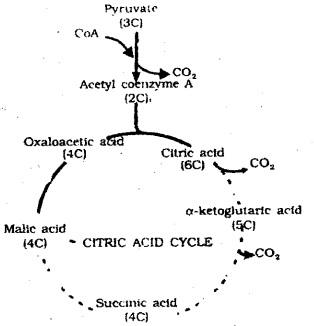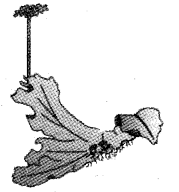Kerala Plus One Botany Previous Year Question Paper March 2018 with Answers
| Board | SCERT |
| Class | Plus One |
| Subject | Botany |
| Category | Plus One Previous Year Question Papers |
Time: 1 Hour
Cool off time: 10 Minutes
Maximum Marks: 30
General Instructions to candidates
- There is a ‘cool off-time’ of 10 minutes each for Botany and Zoology in addition to the writing time of 1 hour each. Further, there is a ‘5 minutes’ ‘preparatory time’ at the end of the Botany Examination and before the commencement of the Zoology Examination.
- Use the ‘cool off time’ to get familiar with the questions and to plan your answers.
- Read the instructions carefully.
- Read questions carefully before you answering.
- Calculations, figures and graphs should be shown in the answer sheet itself.
- Malayalam version of the questions is also provided.
- Give equations wherever necessary.
- Electronic devices except non-programmable calculators are not allowed in the Examination Hall.
Answer all questions from question numbers 1 to 4. Each question carries 1 Score. (4 × 1 = 4)
Question 1.
Fill in the blank.
In Anabaena specialized cells called ……….. help in nitrogen fixation.
Answer:
Heterocyst
Question 2.
There are different types of leucoplasts in plant cells. Name the leucoplast that store proteins.
Answer:
Aleuroplast
Question 3.
Observe the relationship between the first two terms and fill in the blank.
Epipetalous Stamen – Brinjal
…………. – Lily
Answer:
Epiphyllous
Question 4.
Choose the correct answer from the bracket.
First stable product of carbon dioxide fixation in C4 plant is …………..
Answer:
OAA
Answer any seven from question numbers 5 to 13. Each carries two scores. (7 × 2 = 14)
Question 5.
Match the following
| A | B |
| a) Calotropis | i) Vexillary |
| b) China Rose | ii) Valvate |
| c) Cassia | iii) Twisted |
| d) Pea | iv) Imbricate |
Answer:
| A | B |
| a) Calotropis | Valvate |
| b) China Rose | Twisted or Valvate |
| c) Cassia | Imbricate or Valvate |
| d) Pea | Vexillary or Valvate |
Question 6.
Complete the flowchart given below

Answer:
a) secondary xylem
b) meta xylem
c) exarch
d) stem
Question 7.
Ribosomes are organelles without a membrane found in all cells. Name another organelle devoid of membrane, seen in animal cells, Write its function.
Answer:
Centriole or centrosome
Function:
- It act as basal body for cilia or flagella
- In Animal cell spindle fibres originate from centriole
Question 8.
Plants are adversely affected by manganese toxicity. Mention the effects of manganese toxicity in plants.
Answer:
It causes
- Brown spots surrounded by chlorotic veins
- It inhibits calcium translocation in shoot Apex
Question 9.
Following figure shows the citric acid cycle.

Identify the steps where FADH2 and GTP are synthesized.
Answer:
FADH2 – In the conversion of succinic acid to malic acid.
GTP – In the conversion of succinyl CoA to succinic acid.
Question 10.
The given figure shows a plant belonging to liverworts. Identify the plant. Name the asexual buds seen on it and write their features.

Answer:
- The given figure is Marchantia
- The asexual buds are gemmae
- Gemmae are green and multicellular buds
Question 11.
State any four features of facilitated diffusion.
Answer:
- It requires pedal membrane protein
- It is highly selective
- It is sensitive to inhibitors
- Transport rates saturate
Question 12.
Write a note on the phenomenon plasticity exhibited by plants with an example.
Answer:
Plasticity-the structural change in plant in response to different environmental condition.
Heterophylly is an example for plasticity, eg. production of two types of leaves in coriander cotton and larkspur
Question 13.
The breakdown of glucose to pyruvic acid is called glycolysis. Where does it occur in a cell? How many ATP molecules are directly synthesized during this process?
Answer:
Glycolysis takes place in cytoplasm.
The net gain of ATP in glycolysis is 8 (ATP molecules are directly synthesized are 4)
Answer any four from question numbers 14 to 18. Each carries three scores. (4 × 3 = 12)
Question 14.
The tissue found between the upper and lower epidermis of a leaf is called mesophyll.
a) Write the type of cells found in this tissue in a dicot leaf.
b) Mention two differences between a dicot leaf and monocot leaf.
Answer:
a) Palisade and spongy parenchyma
b) 1. In Dicot leaf more stomata are distributed on lower surface while monocot stomata are equally distributed on both surfaces
2. In monocot leaf bulliform cells are present while in Dicot leaf bulliform cells are absent
Question 15.
Photosynthesis is a process influenced by environmental factors as well as plant factors. Mention three factors under each category.
Answer:
- Environmental factors – light, temperature, CO2 concentration and water
- Plant factors – age of leaf, chlorophyll content and orientation of the leaves
Question 16.
First phase of meiosis 1 is typically longer and complex one. Name it. Mention the five subdivisions of this phase.
Answer:
Prophase 1
- leptotene
- zygotene
- pachytene
- diplotene
- diakinesis
Question 17.
Plant growth regulators can be employed for various agricultural and horticultural practices. Identify the growth regulators that can be used for the following purposes.
a) To have weedfree lawns
b) To increase sugarcane length
c) Fruit set in pineapples
d) Rooting in stem cuttings
e) Inhibiting seed germination
f) To promote female flowers in cucumber
Answer:
a) 2,4-D (Auxin)
b) gibberellin
c) ethylene
d) auxin
e) ABA
f) ethylene
Question 18.
Certain stages in cell cycle are given below.
Karyokinesis, Prophase, Cytokinesis, Metaphase, Anaphase, Telophase.
Choose the statements (from those given below) that match with these stages and prepare a table.
- Centromere split and chromosomes move to opposite poles.
- Chromosomes cluster at opposite poles and nuclear envelope assembles around.
- Chromosomes seems to be with two chromatids attached at centromere.
- Chromosomes arranged at spindle equator.
- Separation of daughter chromosomes.
- Division of cytoplasm.
Answer:
- Anaphase
- Telophase
- Metaphase
- Metaphase
- Anaphase
- Cytokinesis
